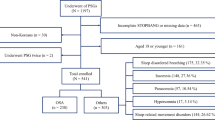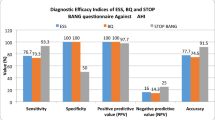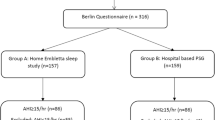Abstract
The incorporation of telemedicine and artificial intelligence for early screening and assessment of severity of life-style disorders has a great potential for better assessment in a busy outpatient clinic and thereby curtail down the related morbidities. A computer based algorithm based upon standardized questionnaire (from established assessment tools) is designed to assess the risk of obstructive sleep apnoea syndrome (OSAS). In addition the incorporation of basic screening questions of anamnesis help in suggesting a probable diagnosis of sleep related disorder as well. The overall data at our center has been analyzed to establish the existing pattern of sleep related disorders. Of 850 healthy subjects screened, prevalence of snoring was 20.47% while OSAS was seen in 4.20% (N = 25) in males and 2.64% (N = 8) in females. The parasomnia was most prevalent (14.71%), followed by insomnia (10.24%), periodic leg movement (6.59%), bruxism (1.65%) and narcolepsy (0.59%). Hypertension, laryngopharyngeal reflux and obesity were the common co-morbidities in OSAS while family history of hypertension and diabetes were common in snorers. A significant association with OSA was seen with diabetes mellitus, neck circumference and nasal obstruction, while, obesity and apnoeic episodes were more significantly associated with OSA than snorers. Increased waist to hip ratio was appreciated in both the OSAS and snorers. The algorithm based online assessment is likely to diagnose the occult clinical cases as well as assess the risk of OSAS. In routine outpatient clinic, a clinician may better assess the patient morbidity with a comprehensive availability of symptoms and moreover enhance the post-treatment compliance. In addition a smartphone based computerized assessment for general population may be designed for other lifestyle disorders as well.


Similar content being viewed by others
References
Johns MW (1991) A new method for measuring daytime sleepiness: the Epworth sleepiness scale. Sleep 14(6):540–545
Carpi MTM, Alonso DP, Marín SG, Mañes CV, Cacacho ALF, Paz CP, Saez SG, Trigo JMM, Vallés EC, Dronda SB (2015) Stop-Bang questionnaire in obstructive sleep apnea syndrome: a severity predictor. Eur Respir J 46:PA2343. https://doi.org/10.1183/13993003.congress-2015.pa2343
Netzer NC, Stoohs RA, Netzer CM, Clark K, Strohl KP (1999) Using the Berlin Questionnaire to identify patients at risk for the sleep apnea syndrome. Ann Intern Med 131(7):485–491
Royant-Parola S, Hartley S, Aussert F, Dagneaux S, Brion A, Aisenberg N, Londe V, Poirot I, Martinot C, Escourrou P (2017) Use of a computer algorithm for defining the care pathway of patients suffering from sleep disorders. Sleep Med 40(1):e283–e284. https://doi.org/10.1016/j.sleep.2017.11.832
Lee YK, Bister M, Salleh YM (2007) A generic algorithm for detecting obstructive sleep apnea hyponea events based on oxygen saturation. In: 2006 3rd Kuala Lumpur international conference on biomedical engineering proceedings, pp 338–341
Young R. Researchers use AI algorithm to help those suffering from sleep disorders. http://trendintech.com/2017/08/15/researchers-use-ai-algorithm-to-help-those-suffering-from-sleep-disorders/. Accessed 4 Nov 2018
Acknowledgements
AM would like to acknowledge Dr. GK Shukla Professor of statistics for his kind help.
Author information
Authors and Affiliations
Contributions
AK, a 3rd year graduate student of computer science from SRM Institute/University, Chennai India was the key person to think and design this computer program. PM and MS assisted her partially wherein PM gave specific inputs in electronic elaboration of biological sufferrings of patients. AK was enrolled in an undergraduate internship program in 2018 at Sleep laboratory of department of Pulmonary Medicine, King George’s Medical University, Lucknow India under the guidance of SK, RG & AS who were critical in teaching her the basic laboratory techniques and their interpretation. Moreover RG of department of pulmonary medicine was critical in initiating a collaboration with department of Otorhinolaryngology (VV, AM) for AK to further organize the institutional data along with her work. In accordance the master thesis work of VY under the chief guidance of AM was integrated with the prospects of this computerized program. VY was the key person to recruit the patients wherein PM participated in patient counselling and data collection. The corresponding author (AM) who was the chief guide and supervisor of VY was the the main person to draft the manuscript and obtaining inputs from AK, VV, SK, RG, AS and Dr GK Shukla (of statistics). All authors read and approved the final manuscript.
Corresponding author
Ethics declarations
Conflict of interest
The computer based algorithm has been designed primarily by AK with partial assistance by PM & MS. In addition www.arth.com of CA USA has been of moderate help generating this idea and helping AK to design the additional algorithm pertaining to body movements and so shares the joint intellectual rights in this regard. In addition AK has also worked in collaboration with www.neodigitech.com (Mr. Ritesh) to manufacture the computer program per se. Furthermore AK intends to utilize the same algorithm to develop a smartphone based free application for general population in order to screen the disorder and to assess the severity of the problem.
Ethical Standards
All procedures performed in studies involving human participants were in accordance with the ethical standards of the institutional and/or national research committee and with the 1964 Helsinki declaration and its later amendments or comparable ethical standards.
Additional information
Publisher's Note
Springer Nature remains neutral with regard to jurisdictional claims in published maps and institutional affiliations.
Rights and permissions
About this article
Cite this article
Katyayan, A., Yadav, V., Mishra, P. et al. Computer Algorithms in Assessment of Obstructive Sleep Apnoea Syndrome and Its Application in Estimating Prevalence of Sleep Related Disorders in Population. Indian J Otolaryngol Head Neck Surg 71, 352–359 (2019). https://doi.org/10.1007/s12070-019-01607-z
Received:
Accepted:
Published:
Issue Date:
DOI: https://doi.org/10.1007/s12070-019-01607-z




